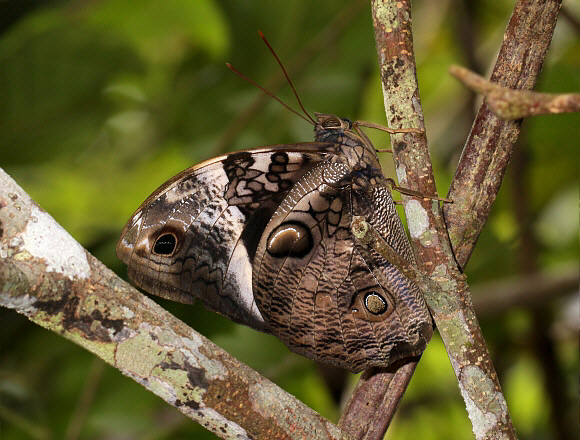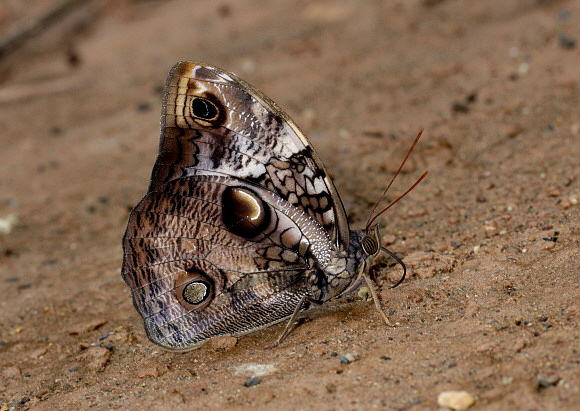 Opsiphanes tamarindi incolumis, Catarata Bayoz, La Merced, Peru – Adrian Hoskins
Opsiphanes tamarindi incolumis, Catarata Bayoz, La Merced, Peru – Adrian Hoskins
Introduction
The Morphinae comprises of about 140-150 neotropical species, of which 93 are included within the tribe Brassolini. Of these 73 are placed in the Brassolina – a subtribe including the genera Brassolis, Blepolenis, Caligo, Caligopsis, Catoblepia, Dasyophthalma, Dynastor, Mielkella, Eryphanis, Penetes, Mimoblepia, Opoptera, Opsiphanes, Orobrassolis and Selenophanes. All Brassolines are crepuscular or nocturnal in behaviour, although a few species also fly by day in the darkest areas of the forest.
The genus Opsiphanes comprises of 11 species distributed variously from Mexico to Paraguay and Argentina. The butterflies are characterised by having a stout thorax and abdomen, large eyes and sturdy antennae. The costa is strongly curved, and the forewing termen is slightly concave. In all species the upperside wings are dark brown in colour with a diagonal orange or yellowish band on the forewings. The undersides are an earthy brown hue. There are dark striations on the outer half of the wings, and heavy marbling at the base. On the hindwings there is a prominent ocellus within which there is a white crescent, and there is a smaller almost circular ocellus near the tornus.
Opsiphanes tamarindi occurs from Mexico to Bolivia. The illustrated subspecies incolumis is found in Peru, the lectotype location being the Chanchamayo valley.
Habitats
This species is found in primary and secondary rainforest, at altitudes up to about 1200m. It also occurs in humid deciduous forest but only flies in such habitats during the rainy season.
Lifecycle
The eggs are globular and pearly white in colour. They are laid singly, usually in mid afternoon, on the trunks, leaf stems, or the underside of leaves of the foodplants. Sometimes clusters of up to 14 eggs have been found but these are thought to be either the result of visits by several females, or of repeated visits by a single female. The eggs are frequently parasitised by the wasp Ooencyrtus submetallicus.
The larvae when fully grown are variable in appearance but are typically green with orange dorsal stripes and a pair of red-brown cephalic horns. They feed nocturnally on Heliconia ( Heliconiaceae ), Canna ( Cannaceae ), Calathea ( Marantaceae ) and Musa ( Musaceae ). The last mentioned genus includes bananas on which tamarindi larvae sometimes become a pest. The larvae are parasitised by wasps including the Braconid Apanteles opsiphanus and Chalcids including Spilochalcis nigrifrons and various Brachymeria species. Dipteran parasitoids include the Tachinid Archaetoneura aletiae.
The pupa can be either green or brown. Pupation takes place within a flimsy silken shelter beneath a leaf. The pupa is parasitised by wasps including the Neotheronia, Brachymeria and Phlugis. It is also attacked by the Pentatomid bug Alcaeorhynchus, and the ants Solenopsis and Parathrechina.
 Opsiphanes tamarindi, Satipo, Peru – Adrian Hoskins
Opsiphanes tamarindi, Satipo, Peru – Adrian Hoskins
Adult behaviour
Opsiphanes tamarindi is crepuscular in behaviour, flying mainly between 1700hrs and nightfall. It is active again between dawn and about 1030hrs, at which time it visits rotting fruit including banana bait. males also visit urine-tainted ground for minerals. The butterflies are sedentary in behaviour, and usually so engrossed in feeding that they are very reluctant to move.
